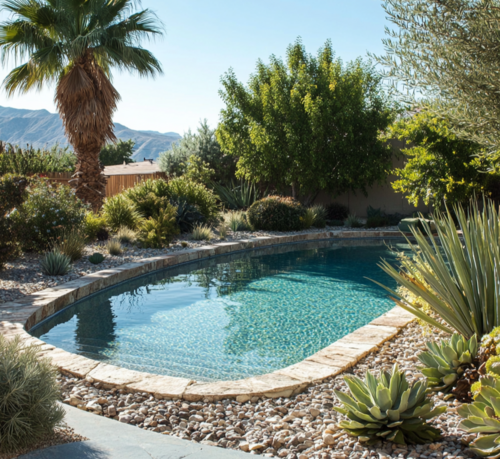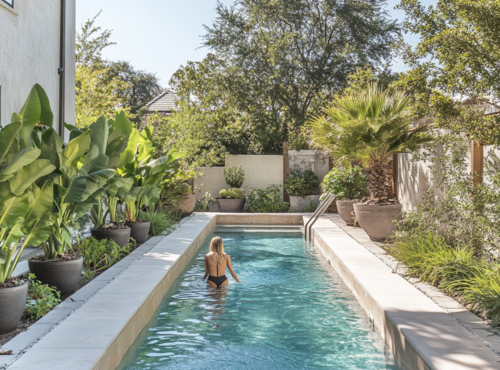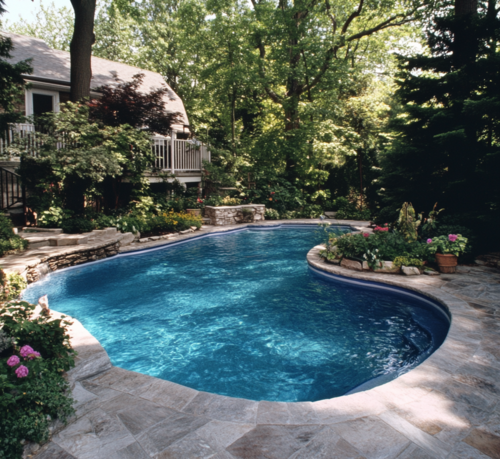Our Top Tips for Growing Plants Around a Pool
Introduction
If you’re fortunate enough to have a pool in your backyard, you may be thinking about how to enhance the area with plants. The right landscaping around a pool can create an inviting atmosphere, increase privacy, and add beauty, but it does require careful planning. Here are our top tips to help you select the ideal plants for a poolside oasis, no matter your space or style preferences.
Choosing the Right Trees for Poolside Landscaping

Backyard Bliss: Poolside Elegance with Flowering Trees
Adding trees around a pool area can provide shade, enhance privacy, and create a beautiful backdrop. However, not all trees are suited for poolside planting. Here are key factors to help you select the best trees for a low-maintenance, visually appealing poolside landscape.
Select Trees with Shallow Root Systems
To avoid issues with pool plumbing and cracking pavement, choose trees with shallow, noninvasive roots. Trees like Japanese maples, palms, and crape myrtles have root systems that are less likely to disrupt nearby structures, making them ideal choices for pool areas.
Choose Low-Mess Varieties
Opt for trees that don’t shed excess leaves, seeds, or fruit, which can clog pool filters and create additional cleanup work. Evergreens like cypress, some pine varieties, and palms are great low-litter options. Avoid messy varieties like oaks, which drop acorns and large amounts of leaves.
Mind Height and Spread for the Perfect Fit
Consider the mature height and spread of each tree to ensure it complements your pool area without overshadowing or blocking scenic views. Smaller trees like dwarf citrus or ornamental cherries provide ample shade without overwhelming the space, making them ideal for poolside settings.
Opt for Container-Friendly Options for Flexibility
In areas with extreme weather, container-grown trees provide flexibility. These can be moved indoors or to sheltered areas during storms, protecting both the tree and your pool. Small palms, olive trees, and dwarf citrus varieties work well in large containers and bring a stylish look to your poolside.
Consider Climate-Specific Choices
Choose trees suited to your specific climate zone for reduced maintenance and better longevity. For example, citrus trees and hardy palms thrive in warm, Mediterranean climates, while junipers and certain pines are more suited to cooler zones.
Ensure Aesthetic Compatibility with Your Theme
Select trees that complement the overall theme of your pool landscape. For a tropical vibe, palms and banana trees bring a resort-like feel, while Japanese maples and olive trees enhance a Mediterranean or minimalist design, making your space feel cohesive and intentional.
Add Seasonal Interest and Privacy
Trees with multi-season appeal, such as crape myrtles that bloom in summer and have colorful fall foliage, add visual interest year-round. For privacy, consider tall shrubs or small trees like bamboo and bay laurel to create a natural screen, ensuring a secluded pool area.
Succulents and Cacti for Low-Maintenance Poolside Beauty

A Refreshing Desert Retreat with Stunning Landscaping
Succulents and cacti are ideal for poolside landscaping due to their low water needs, bold textures, and minimal upkeep. Thriving in full sun, they add a unique, modern look that complements any pool area.
- Low Water Requirements: These drought-tolerant plants are perfect for sunny poolside spots, as they store water in their leaves, allowing them to endure dry spells.
- Variety in Texture and Color: Succulents and cacti come in many shapes and colors, from rosettes like echeveria and colorful options like Aloe cameronii to smooth, pool-friendly choices like cotyledon and aeonium .
- Safe and Stylish Selections: For poolside safety, opt for succulents with smooth edges. Kalanchoe , cotyledon, and aeonium add lush beauty without sharp spines. For thorny cacti, place them in low-traffic areas as focal points.
- Design Tips: Create visual impact by combining succulents with gravel or rock beds. Large ceramic pots can add height and interest, allowing you to reposition plants easily as needed.
- Minimal Maintenance: Succulents and cacti require little more than occasional watering and well-draining soil to prevent root rot. Most are pest-resistant and need only occasional grooming to remove dead leaves.
By adding succulents and cacti around your pool, you can enjoy a lush, beautiful, and low-maintenance landscape that thrives in the sun and requires minimal care.
Embracing Container Gardens for Flexibility

Modern Serenity: A Tropical Backyard Pool Retreat
Container gardens offer versatility, style, and easy maintenance for poolside landscaping. By using containers, you can rearrange plants, protect them during extreme weather, and experiment with various designs. Here’s how to create an effective poolside container garden:
Versatile Planting Options
With container gardening, you can switch plants seasonally or try different combinations. Hardy plants like agave, lavender, and dwarf palms thrive in sunny poolside spots, while evergreen shrubs add year-round greenery.
Choosing Durable Containers
Select weather-resistant containers in materials like ceramic, stone, or fiberglass, which withstand sun and moisture. Self-watering containers are ideal for hot areas, helping keep plants hydrated with minimal effort.
Ideal Poolside Plants
Compact, resilient plants such as succulents, dwarf citrus, and flowering perennials like geraniums are perfect for containers. Dwarf banana plants and small palms add a tropical flair and height to the space without overwhelming it.
Grouping Containers for Visual Appeal
Group containers of varying heights and sizes for a dynamic, layered look. Tall pots with palms or grasses add structure, while smaller pots with colorful blooms or succulents provide texture and color around seating areas and pathways.
Practical Care Tips
- Watering: Self-watering containers or drip systems can help prevent soil from drying out.
- Fertilizing: Use slow-release fertilizers to keep plants healthy, especially in the growing season.
- Drainage: Ensure pots have drainage holes to prevent root rot.
- Seasonal Adjustments: In colder climates, move sensitive plants indoors during winter.
Container gardens add flexibility, making it easy to refresh your poolside landscape and personalize the design. With the right plants and containers, you’ll create a vibrant, low-maintenance oasis that complements your pool area year-round.
Adding Privacy with Vines and Climbers
Vines and climbing plants are an excellent way to introduce natural privacy and shade around your pool. Fast-growing and versatile, they can transform fences, trellises, pergolas, or walls into lush green screens that provide seclusion and enhance the ambiance of your outdoor space. Here’s how to make the most of vines and climbers in your poolside landscaping:
Fast-Growing Privacy Options
Vines are ideal for quickly creating privacy around a pool. Popular choices include jasmine, passionflower, honeysuckle, and Lady Banks rose . These vines establish themselves quickly, adding greenery and floral interest while screening the pool area from neighboring views. Many of these varieties also have a sweet fragrance, adding an inviting touch to your outdoor oasis.
Choosing the Right Support Structure
To get the best results from your climbers, set up sturdy support structures that fit your landscaping needs. Trellises and arbors are perfect for defining poolside zones, while a pergola can add overhead shade and a cozy, cabana-like feel. For a more subtle look, lattice fencing or even wire cables strung along a wall offer great support for lightweight vines and enhance privacy without taking up additional ground space.
Selecting Pool-Friendly Vines
Not all vines are suited for pool areas, so select varieties that are easy to maintain and won’t shed heavily. Consider low-litter options like star jasmine, which is hardy and evergreen, or bougainvillea, which offers vibrant color with minimal shedding. For a tropical look, climbing philodendron or mandevilla can add lush greenery and bright blooms.
Creating Shade with Climbing Plants
Vines can also serve as a natural shade canopy. Climbers trained over a pergola or arbor can shield the pool area from direct sunlight, making it cooler and more comfortable. Wisteria, for instance, grows beautifully over overhead structures, adding not only shade but also seasonal blooms for a striking effect.
Seasonal Considerations and Maintenance
Keep seasonal needs in mind when selecting vines. Some, like passionflower, are deciduous and may lose their leaves in colder months, while evergreen vines like ivy provide year-round coverage. Regular pruning will encourage healthy growth and prevent vines from becoming overly dense, which can block airflow and sunlight.
Key Considerations When Selecting Poolside Plants

Escape to Nature with a Woodland Pool Paradise
Choosing the right plants for your poolside landscape is essential to create a low-maintenance, beautiful, and functional space. Here are the key factors to keep in mind.
Climate Compatibility
Select plants that naturally thrive in your local climate. Drought-tolerant choices like lavender and agave are ideal for hot, dry areas, while humidity-loving plants like ferns and bamboo do well in tropical zones. Climate-compatible plants need less water and maintenance, keeping your pool area lush and easy to manage.
Sun Exposure and Heat Tolerance
Poolside areas get extra sun and heat from reflected surfaces, so choose plants that can handle these conditions. Heat-tolerant options like succulents, ornamental grasses, and Mediterranean herbs are ideal for full sun. Plants with thick leaves, like agave, retain moisture better, making them perfect for hot areas.
Noninvasive Root Systems
Choose plants with shallow, noninvasive roots to avoid damage to pool plumbing or pavement. Small trees like dwarf palms and shrubs like boxwoods are excellent for adding structure without risking your pool’s infrastructure.
Low-Mess Varieties
Opt for evergreens or self-cleaning flowers like hibiscus and bougainvillea to reduce debris in the pool. Low-litter plants keep your pool and filter cleaner, cutting down on maintenance time.
Salt and Chlorine Tolerance
Select plants that can tolerate salt or chlorine splash. Daylilies, lavender, and Mexican feather grass are hardy choices that withstand occasional chemical exposure, keeping your garden healthy around both saltwater and chlorine pools.
Size and Growth Habits
Choose plants with controlled growth to avoid overcrowding. Compact shrubs, dwarf palms, and small perennials work well for poolside landscapes without blocking views or creating excessive shade.
Aesthetic Harmony with Pool Design
Match your plant choices to your pool theme. Tropical plants like bird of paradise add lush greenery, while Mediterranean options like olive trees and Italian cypress create a cohesive look with more refined pool styles.
Low-Maintenance and Water-Efficient Options
Opt for plants that align with your maintenance preferences. Drought-tolerant plants like succulents and ornamental grasses require less water and care, making them ideal for low-maintenance gardens. Self-watering containers or drip irrigation can simplify care, especially in the summer.
Considering these factors will help you choose plants that thrive around your pool, enhance its aesthetic, and reduce maintenance, making your outdoor space more enjoyable year-round. With careful plant selection and thoughtful arrangement, your poolside area can become a stunning outdoor retreat that’s as beautiful as it is functional.
Originally posted on February 22, 2019.


